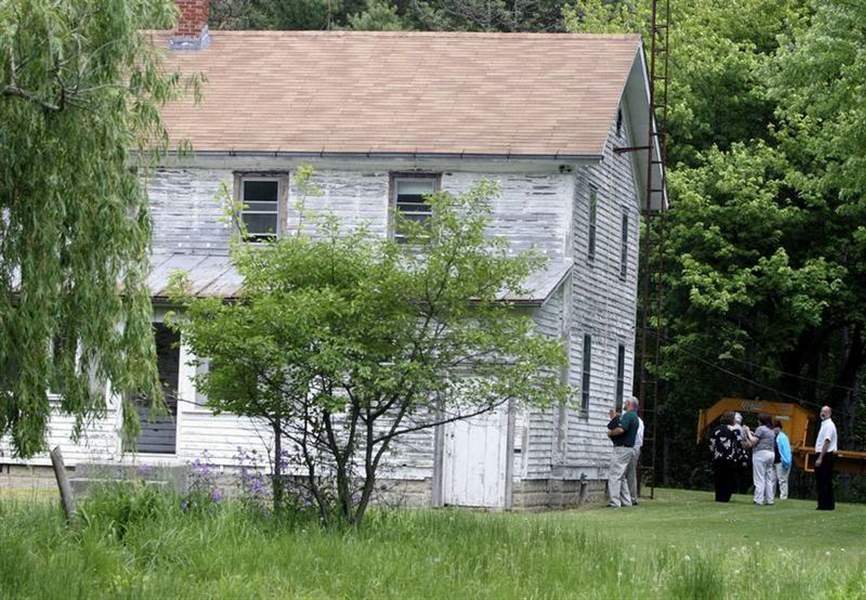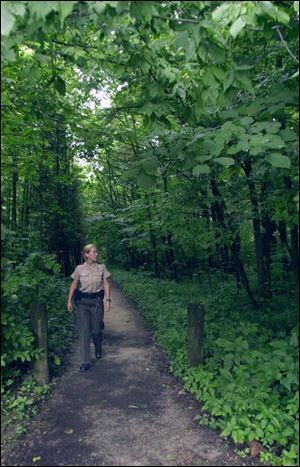
Goll Woods in Archbold spins tall tale of history
6/30/2008
Visitors inspect the old homestead at Goll Woods State Nature Preserve. The Friends of Goll Homestead in 2005 restored the 143-year-old barn and now plans to turn the house into an education center.

Visitors inspect the old homestead at Goll Woods State Nature Preserve. The Friends of Goll Homestead in 2005 restored the 143-year-old barn and now plans to turn the house into an education center.
Sticking close to home this summer? Short Stops will help steer readers toward day trips that won't burn a tank of gas. Short Stops will appear each Monday throughout the summer.
ARCHBOLD, Ohio - Hundreds of years ago, deep in Ohio's Great Black Swamp, a 112-foot-tall bur oak tree loomed over the woods.
It saw Chevalier Robert de la Salle, a French fur trader who explored the region in 1679, trekking through the soupy marsh.
It saw Peter Goll, a French immigrant, settling along the banks of the Tiffin River.
And then it saw Ohio's Department of Natural Resources convert 321 acres of wilderness into Goll Woods State Nature Preserve.
The tree died in 2006, but its massive trunk is still a formidable focal point of the preserve's 1-mile Bur Oak Trail.

Park employee Jamie Murphy walks along one of three hiking trails at Goll Woods State Nature Preserve in 2001.
The Goll Woods State Nature Preserve, in Fulton County just north of Archbold, is one of few remaining vestiges of the Great Black Swamp. Its wet nature and dense foliage are reminiscent of the Black Swamp, which was a glacially caused wetland that sprawled across northwest Ohio until the late 19th century.
Now, the swamp has been drained and much has been converted to farmland.
"Goll Woods is a great piece of history," said Ron Dilbone, who has volunteered at the preserve for 13 years.
Part of the swamp was purchased from the U.S. government in 1837 by Mr. Goll, who was awestruck by the majestic oak and cottonwood trees. Mr. Goll first bought 80 acres for $100; his farm eventually grew to 600 acres.
In 1966, Mr. Goll's great-granddaughter, Florence Goll Louys, and her children sold the land to the state. Since then, it has been under the guardianship of the Department of Natural Resources.
The property includes a house and barn, both more than 140 years old, that caused a bit of an uproar after the state announced demolition plans for the two structures in 2001.
A nonprofit group, Friends of Goll Homestead, materialized in support of the historic buildings. "They have a very unique form of architecture," said Kris Jemmett, treasurer of the group. "The design of the house and barn looks as though the structures were built in Europe."
The group hopes to convert the house to an education center so visitors can "have a warm and dry place to study the leaves they've collected and learn about the place," Ms. Jemmett said.
In recent years, the project has been funded by state grant money. Graduate students from Eastern Michigan University, Ypsilanti, have helped restore the house.
Goll Woods is renowned for its enormous trees, which have grown to 122 feet and are some of the largest left in the state.
"You're not gonna find trees this old anywhere in this area," Ryan Schroeder, preserve manager, said. "To have an oak tree die of old age is pretty rare."
The preserve has the silent, hallowed air of a church sanctuary, punctuated by bird calls and the rustle of leaves.
In the summer, the trails are especially empty because of a vicious tide of mosquitoes that sweeps through the woods.
The best time to visit is springtime, when a diverse population of wildflowers is in bloom.
"My favorite is the large-flowered trillium," Mr. Schroeder said. "It's really big and bold. And when you see a large patch of them, it's a really nice sight."
This spring, the park offered a guided wildflower hike, and almost 40 people showed up.
Other spring flowers include the whimsical Dutchman's breeches, which have petals shaped like an inverted pair of pants, and the delicate, lacy foamflower.
The preserve is home to many varieties of birds, including cardinals, woodpeckers, and hawks.
Visiting Goll Woods in the fall or winter also has advantages. In the fall, the foliage blooms into rich shades of orange and red, and the temperature is more comfortable. In the winter, cross-country skiing is popular.
The preserve has three hiking trails: the Bur Oak, Cottonwood, and Tuliptree trails.
Visitors can fish in the Tiffin River, but the water is too murky for swimming.
The big trees are dying off slowly, felled by old age, storms, and insects. Near the start of the Bur Oak Trail, a small tree lies uprooted, its vein-like roots dangling. But as the detritus is recycled by the forest, new flora continues to emerge.
"At Goll Woods, you're in the country, away from traffic," Mr. Schroeder said. "You can be here and really feel like you're out in the wilderness."
Contact Laura Bennett at:
lbennett@theblade.com
or 419-724-6728.